Five new images from Chandra reveal cosmic objects in X-ray wavelength
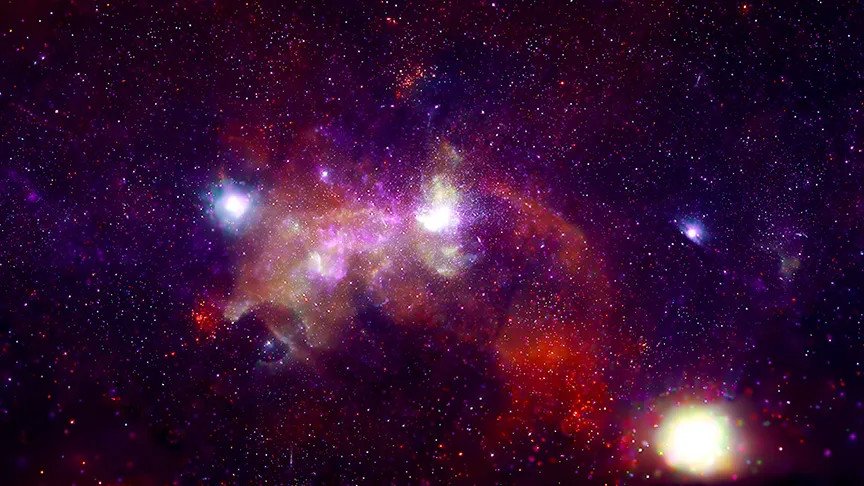 The first image in the collection is titled Galactic Center. Here, the center of the Milky Way galaxy resembles a pink, orange, red, and purple cloud, dotted with several brilliant orbs of light. Surrounding the cloud is a dense field of purple, orange, red, and pale blue specks that entirely blanket the sky. In this image, orange, blue, and purple represent X-ray light from the Chandra X-ray Observatory. NASA/CXC/SAO, JPL-Caltech, MSFC, STScI, ESA/CSA, SDSS, ESO
The first image in the collection is titled Galactic Center. Here, the center of the Milky Way galaxy resembles a pink, orange, red, and purple cloud, dotted with several brilliant orbs of light. Surrounding the cloud is a dense field of purple, orange, red, and pale blue specks that entirely blanket the sky. In this image, orange, blue, and purple represent X-ray light from the Chandra X-ray Observatory. NASA/CXC/SAO, JPL-Caltech, MSFC, STScI, ESA/CSA, SDSS, ESO
Sep 17: A series of five new images from NASA’s Chandra X-ray Observatory show the beauty of space as seen in the X-ray wavelength. Data from Chandra has been combined with data from other telescopes operating in visible light and infrared wavelengths to show some of the unique features of the high-energy universe.
The images show a range of objects from the heart of the Milky Way to supernova remnants, each one combining different sets of data to create a stunning view of an object that couldn’t be perceived in this way by human eyes.
The center of our galaxy, shown above, is a busy region full of objects like massive stars, incredibly dense neutron stars, superheated clouds of gas, and a supermassive black hole named Sagittarius A*. The clouds of bright color show the presence of energy in the X-ray wavelength.
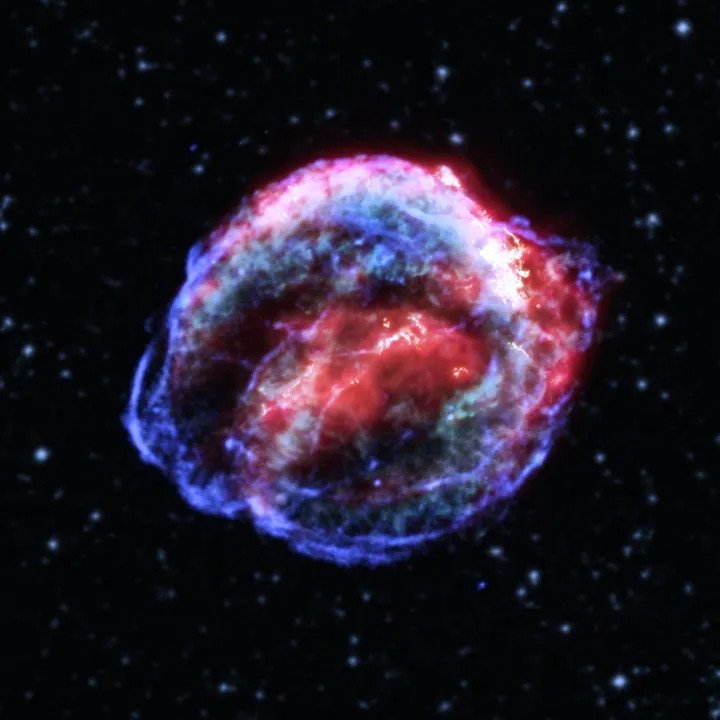
[The second image features Kepler’s Supernova Remnant, the remains of a white dwarf star that was destroyed by a thermonuclear explosion. The remnant resembles a knotted ball of crackling blue, red, and white energy, set against a black sky dotted with pale blue specks. Here, red streaks and patches of mottled turquoise represent debris from the destroyed star. A web of translucent electric blue veins that encircles and weaves through the knot represents the powerful blast wave captured by Chandra. NASA/CXC/SAO, JPL-Caltech, MSFC, STScI, ESA/CSA, SDSS, ESO]
When a massive star reaches the end of its life and explodes as a supernova, the shockwave from the explosion can reach out far into space and interact with nearby dust and gas to form a supernova remnant. These shells appear around the site where the star exploded, and this image combines optical, infrared, and X-ray observations to show the different parts of the remnant like the debris and the blast wave.
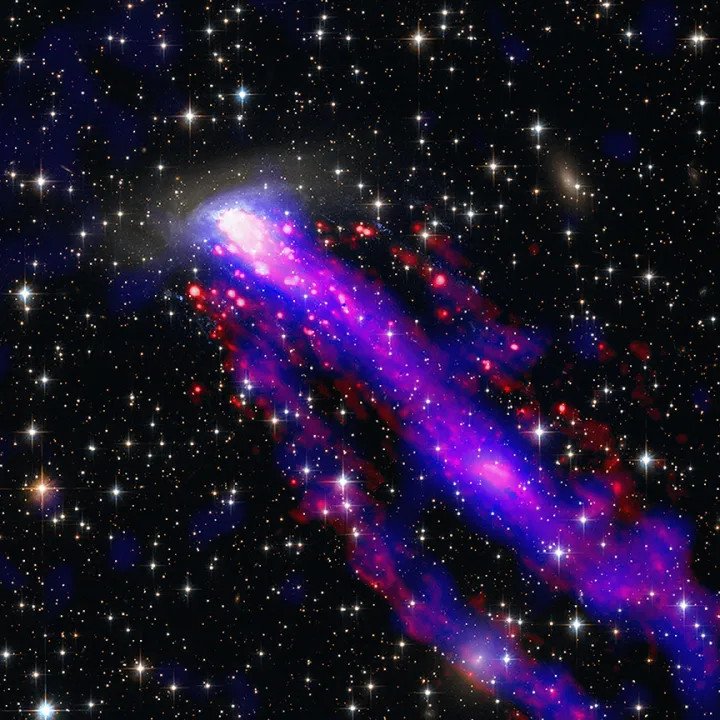
[In the third image, a bright, pale pink light encircled by translucent blue swirls rockets toward our upper left, leaving two, long, pink and purple tails behind it. This is ESO 137-001, a galaxy moving through space at 1.5 million miles per hour. Set against a black background packed with gleaming stars, the galaxy’s twin tails feature streams of pink floating inside superheated purple gas. Clusters of red dots, hydrogen atoms, appear to travel with the galaxy, alongside the flowing tails. In this image, X-ray light is represented by blue. NASA/CXC/SAO, JPL-Caltech, MSFC, STScI, ESA/CSA, SDSS, ESO]
This galaxy zips through space at a tremendous speed of 1.5 million miles per hour, leaving a dramatic pair of tails in its wake. As the galaxy moves, it trails superheated gas which gives off X-rays that Chandra can observe, shown in blue. The patches of red are hydrogen, which was observed in the infrared. Visible light is represented in orange and cyan.
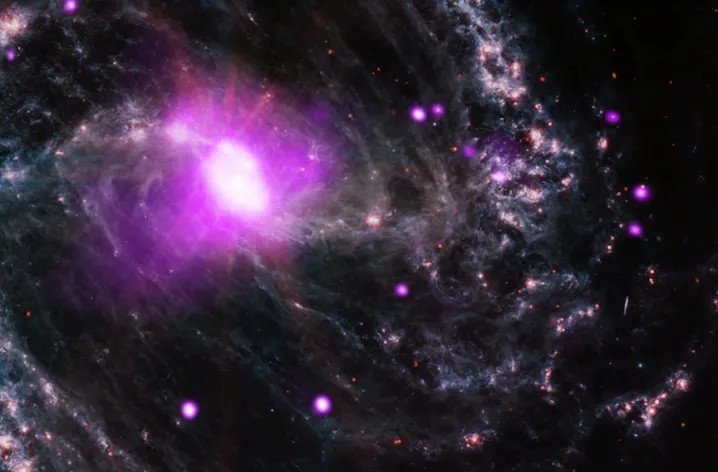
[The fourth image in this release features a close-up of the spiral galaxy NGC 1365, and the supermassive black hole at its center. Here, the galaxy is shown at a dramatic angle, as if the bright pink core is gazing past our right shoulder. Swirls of pale, grey-blue material, resembling waves in a dark ocean, spiral toward the radiant pink core, which hangs at our upper left. Glowing pink circles, and flecks of red, dot the churning spiral galaxy. In this image, X-ray light captured by Chandra is rendered in hot pinks and purples. NASA/CXC/SAO, JPL-Caltech, MSFC, STScI, ESA/CSA, SDSS, ESO]
Like our galaxy and most others, NGC 1365 also hosts a supermassive black hole at its center. This image shows the hot gas swirling around the black hole in purple, as it gradually falls in and the black hole devours it. The Chandra X-ray data is combined with infrared data from the James Webb Space Telescope.
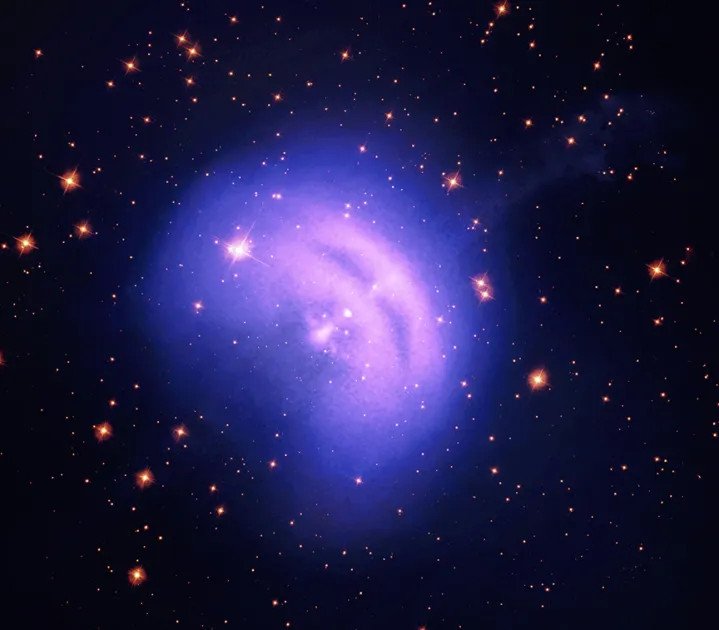
[The fifth and final image of this release features the Vela Pulsar, the aftermath of a collapsed and exploded star sending a jet of particles into space. The pulsar resembles a soft, pillowy, lavender bean in a pocket of blue gas. A faint stream of gas, the X-ray jet, appears to shoot from the pocket, heading into the distance at our upper right. Purple markings in the lavender bean shape strongly resemble narrow eyes and an open mouth, giving the pulsar a squinting happy face. In this image, X-ray light is shown in blues and purples. NASA/CXC/SAO, JPL-Caltech, MSFC, STScI, ESA/CSA, SDSS, ESO]
Finally, another supernova remnant is shown here. Within the remnant is a pulsar, a type of neutron star that has a strong magnetic field and which gives off regular pulses of energy in high wavelengths like X-ray and gamma-ray. The purple glow is X-ray energy captured by Chandra, while blue light is from another X-ray telescope called IXPE. It is set over a background of stars captured in the visible light wavelength.
(Digital Trends)






Leave Comment